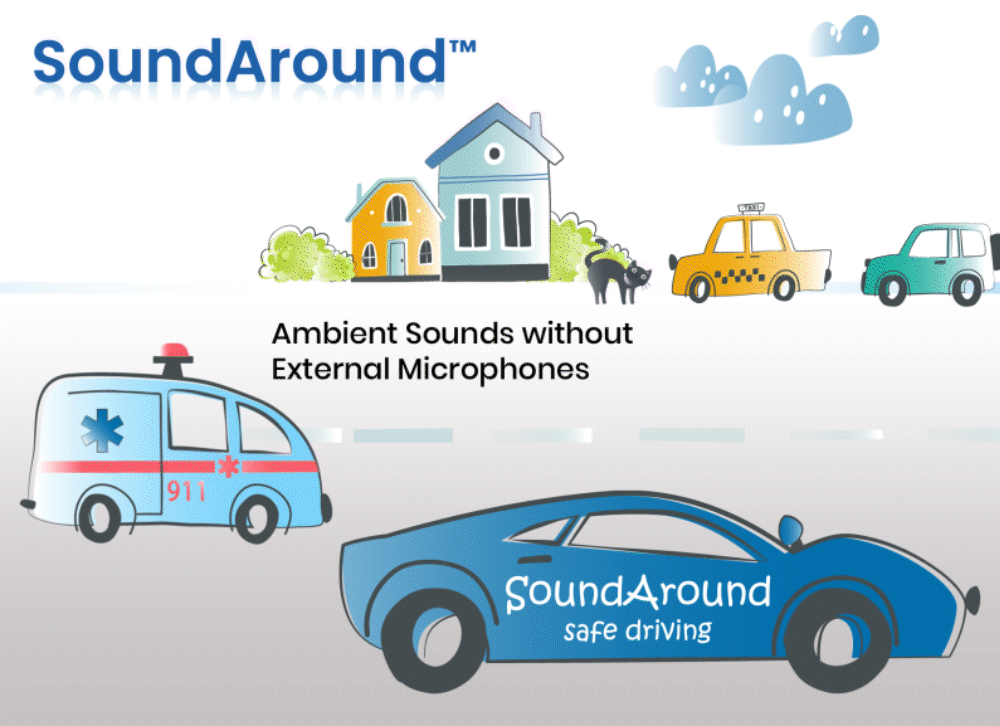|
SoundAround: Ambient Sound Detection |
| c |
|
 |
|
SoundAround™ - a breakthrough ambient sound detection and acquisition technology for automotive applications that does not require microphones outside the vehicle. This technology facilitates the detection of important sounds on the road, such as sirens, which are critical for alerting drivers as well as autonomous driving vehicles to potential hazards. It also captures various other sounds that provide context for accompanying circumstances in all incidents, including traffic, weather, and voices. It can even enable a vehicle sound transparency mode, allowing people in the car to hear through closed windows. Incidents of vehicle damage, including vandalism or attempted theft (carjacking), can be recorded, in addition to the voices of the offenders, for later identification. The traditional solution relies on placing microphones outside the vehicle cabin, which is very difficult and costly. Microphones are very sensitive elements that, without special protection, cannot withstand the harsh environmental conditions outside the vehicle, including rain, wind, snow, hail, stones, oil, cleaning chemicals and high-pressure jet washers.
|
 |
h | Alango’s SoundAround™ technology utilizes a voice pickup module that is affixed to the car's windshield or any other window. The key element of the pickup module is a vibration sensor that is mechanically coupled to the glass to capture external sounds via the glass vibration caused by those sounds. Sound pickup via vibration of a sound barrier is not new. | h |
|
However, vibration is symmetrical and does not depend on whether it is caused by external sounds of interest or internal, in-car sounds such as loud music played or car passenger conversation. The core of Alango’s patent pending SoundAround™ technology is Alango's signal processing software, which effectively "cleans" the signals from the vibration sensor(s) from components corresponding to internal sounds. Additionally, it can clean the signal from irrelevant road noise and other interference. Using multiple sound acquisition modules facilitates direction finding by making use of the time of arrival difference.
Use control buttons on the interactive screenshots to play/stop/navigate
|

Outside siren inside a car with radio (VOICE)
|
OUTSIDE MICROPHONE
Siren as recorded by outside microphone |
IN·CABIN MICROPHONE
Siren + inside voice as recorded by in·cabin microphone |
|
|
VIBRATION SENSOR
Siren + inside voice as recorded by the vibration sensor |
SoundAround™ OUTPUT
Vibration signal after inside voice is cancelled by SoundAround™ |
Outside siren inside a car with radio (MUSIC)
|
OUTSIDE MICROPHONE
Siren as recorded by outside microphone |
IN·CABIN MICROPHONE
Siren + inside music as recorded by in·cabin microphone |
|
|
VIBRATION SENSOR
Siren + inside music as recorded by the vibration sensor |
SoundAround™ OUTPUT
Vibration signal after inside music is cancelled by SoundAround™ |

Outside voice inside a car with radio (VOICE)
|
OUTSIDE MICROPHONE
Outside voice as recorded by outside microphone |
IN·CABIN MICROPHONE
Outside voice + inside voice as recorded by in·cabin microphone |
|
|
VIBRATION SENSOR
Outside voice + inside voice as recorded by the vibration sensor |
SoundAround™ OUTPUT
Vibration signal after inside voice is cancelled by SoundAround™ |
Outside voice inside a car with radio (MUSIC)
|
OUTSIDE MICROPHONE
Outside voice as recorded by outside microphone |
IN·CABIN MICROPHONE
Outside voice + inside music as recorded by in·cabin microphone |
|
|
VIBRATION SENSOR
Outside voice + inside music as recorded by the vibration sensor |
SoundAround™ OUTPUT
Vibration signal after inside music is cancelled by SoundAround™ |
SoundAround™ is available on most MCU/DSP cores.
|
| p | |||
| p |  |
p | |
| p | p | ||